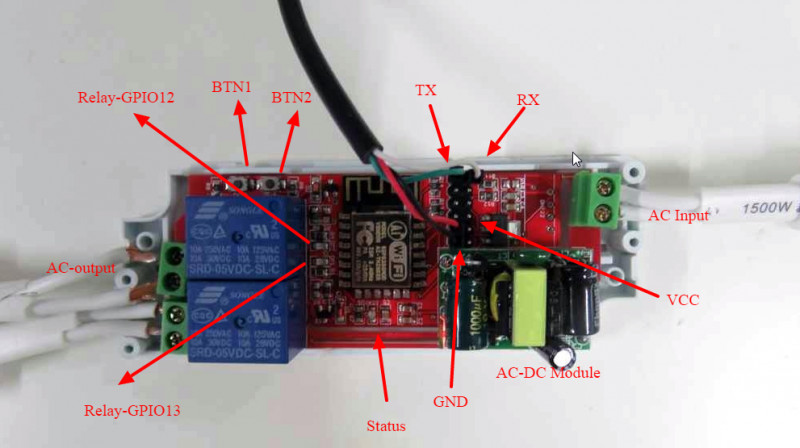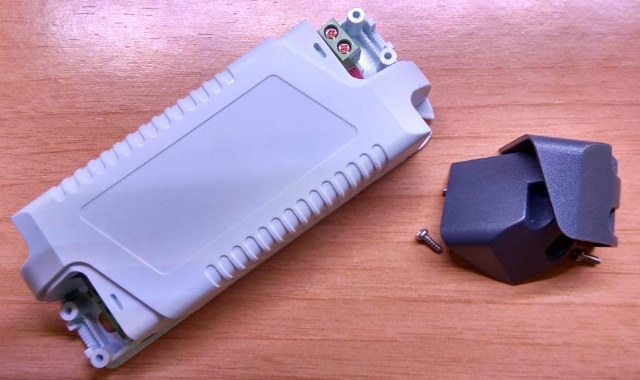Thanks to ESP8266, the cost of WiFi relays has dramatically come down, but so far, I could not find an all-in-one solution with ESP8266, relay, AC power and enclosure, and for example I’m still using NodeMCU board, a relay board, a USB power supply, and put all that into a plastic jar in order to control a water pump. It works but it’s not ideal, and solutions like Wemos D1 mini with relay shield improves things further, but Electrodragon has come with a connect-and-play WiFi IoT relay that integrates everything including the case for $6 + shipping.

Wifi IoT Relay Board Based on ESP8266:
- WiFi module – ESP-12F based on Espressif ESP8266EX WiSoC
- Relays – 2x Songle SRD-05VDC-SL-C relays supporting 125VAC/10A, 250VAC/10A, 30VDC/10A, 28VDC/10A
- Input/Output – 3x terminal blocks for relay and power
- Expansion – 12-pin header with Rx/Tx, GPIO4, Btn2, GPIO15, 5V/GND, ADC, GPIO5, Btn1, OUTPUT1, and 3V3
- Debugging – Serial pins accessible on header for programming the board with your own firmware
- Misc – 2x buttons, 2x LEDs for relay, 1x status LED
- Power – 1x terminal block for AC input; AC 85-265V to DC 5V power module
- Dimensions – N/A, but small 🙂
 The enclosure appears to protect well enough against dust, or a few water drops, but I would not put it under the rain…
The enclosure appears to protect well enough against dust, or a few water drops, but I would not put it under the rain…
The board is pre-loaded with ESP8266 AT firmware, but you can connect a USB to TLL debug to program with the demo code firmware available from the Wiki. The demo firmware used NodeMCU LUA firmware and www.cloudmqtt.com.

I found the product via Pete Scargill Blog, where he has started testing the device, and experimenting with his own firmware.
It’s actually quite similar to IteadStudio’s Sonoff, except it does not support RF, and features two relays instead of just one, and now that the crowdfunding campaign is over, you can purchase it for $4.85 (WiFi only), or $7.20 (WiFi + RF) plus shipping. Both Electrodragon and Iteadstutio provide affordable shipping for a couple of dollars. One more thing they almost certainly have in common is the lack of UL/ETL safety certifications, so that means your insurance may not cover fire hazard if they found this type of products in your home, and they have not been certified to be safe, so you’d have to rely on your own, or the community, judgment. One buyer also noted that “AC lines on the PCB are quite thin”, and Peter also had a similar comment: “the two tracks bringing power right across the board from the mains to the two relays – while being nicely isolated by an air gap which is GOOD, are WAY too thin to handle a total of 20 amps”, so the current design is unlikely to be suitable to handle two high loads at the same time.

Jean-Luc started CNX Software in 2010 as a part-time endeavor, before quitting his job as a software engineering manager, and starting to write daily news, and reviews full time later in 2011.
Support CNX Software! Donate via cryptocurrencies, become a Patron on Patreon, or purchase goods on Amazon or Aliexpress





Be careful with those generic-brand blue relays. In my experience, over time they can’t handle anywhere near the name-plate rated current (expect bad things to happen when the contacts eventually fail). If you need any decent load current capability, replace the relays with known good drop-in replacements from the start. Also, it looks like the relay coils are not opto-isolated for safety (a lesser concern if you have known-good relays). At least there is mention of isolation slots. If the mains PCB traces are too thin to handle your current requirement, just plate the traces with a thick layer of solder (which should have been done at the factory).
@Drone
Would you know one or two good relays?
Songle SRD-05VDC-SL-C — that relay seems to be ok.
Here is the datasheet:
https://www.ghielectronics.com/downloads/man/20084141716341001RelayX1.pdf
They are spec’d to take 10 amps.
They link to their UL file number:
UL /CUL FILE NUMBER: E167996 10A/125VAC 28VDC
Now that does not mean this entire board is ok. If you are running 10A of AC around the board you likely need 2oz copper. Did they spec 2oz copper? Did they follow UL spec for minimum spacing between the PCB traces on their PCB?
This is why you have to go through UL/CUL again for the entire system. Using UL spec’d components like these relays saves on the full system UL, but it doesn’t let you avoid it.
More worrisome is that AC-DC module. It is likely one that is used in USB walwarts. Does it have UL? There are hundreds available with UL rating, why pick one that doesn’t have it? We know that improperly designed power supplies can kill people.
Did it come with those plugs and outlets? Because they certainly fail UL. UL requires that there be strain relief (like a knot in the cord) to keep you from tripping over the wire and pulling them out of the screw connectors. Just consider what happens if you pull the input plug out of the screw terminals — you are going to have a wire with deadly level AC on it flopping around.
Watch ElectroDragon hidden brokerage fees if you do not use anything other than simple China Post. I paid more for shipping and C.O.D. fees than I did for the parts, and that was using China Post Canada Post service. Somehow went via Belguim Post. Customer service blamed me for not paying attention to section 6 of their “agreement”. My country never charges customs fees via COD. Go elsewhere.